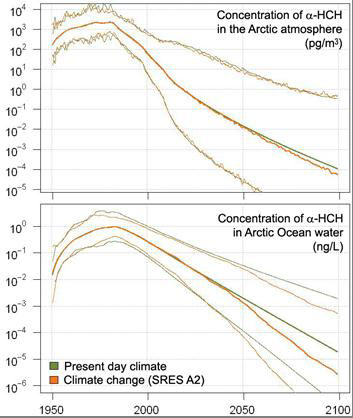Emissions, pathways and modelled impacts of climate change: HCHs
HCHs were modelled using BETR Research and DEHM. The BETR Research modelling considered the lifecycle of use of HCHs from 1945 to 2050, and evaluated model results against measurements in air and ocean water in the period 1985 to 2010. Modelled concentrations of HCHs in the Arctic were found to be only slightly sensitive to recent climate variability, and forecast concentrations in Arctic air and ocean water were lower by factors of two and five, respectively, under a climate change scenario compared to present-day climate. The BETR Research model results suggest that the Arctic Ocean is a sink for HCH from primary sources and stronger secondary sources elsewhere. DEHM model experiments that assumed the same emissions under two climate scenarios showed higher atmospheric concentrations of HCHs in the Northern Hemisphere under a climate change scenario. All modelled effects due to climatic trends are small compared to the decline in absolute HCH concentrations that occurred over the past decade as a consequence of its phase-out.
The DEHM model predicted that α-HCH concentrations in Arctic Ocean water and soils will decrease under a climate change scenario. However, air concentrations over Arctic will increase as a result of increased re-volatilisation from sources further south and thereafter atmospheric transport into the Arctic.
BETR Research model
The BETR Research model was used to study transport pathways and fate of HCH. Results showed that during a rise in globally averaged air temperatures after the mid-1990s, air concentrations of HCH increased. Enhanced volatilization from secondary sources was dominating the oppositely directed effect of faster degradation with higher temperatures. Decreasing sea-ice cover resulted in reduced concentrations in air, about 2 percent and 5 percent for α- and β-HCH, respectively. The effect is evident in particular for β-HCH in late 2007, when the monthly sea-ice extent in the Arctic dropped to a historical minimum.
To forecast effects of climate change the model was run based on the 20C3M and the SRES A2 scenarios. The model was run to predict α-HCH concentrations. The influence of climate change on modelled concentrations of α-HCH becomes notable in the second half of the 21st century. By the year 2100, modelled concentrations of α-HCH are lower by a factor of two in the Arctic atmosphere, and lower by a factor of five in Arctic Ocean water in the climate change scenario compared to the present-day climate scenario. Complete details of this model experiment are reported in Wöhrnschimmel et al. (2012). See figure below.
As an investigation of causes of the recent discontinuity of β-HCH in the Arctic atmosphere the BETR Global model was used to test the hypothesis that despite the ban on the use of HCH, an increase in secondary emissions is delaying the decrease of β-HCH in air in the Arctic. The seasonal peak atmospheric concentration of β-HCH in Arctic air has changed from spring when there were primary emissions from agricultural use to later in the summer after the year 2000, when secondary sources became dominant. The model runs reproduced concentration patterns in Arctic air and thus confirmed the hypothesis.

DEHM model
The influence of climate change on the fate and transport of α-, β- and γ-HCH was modelled using the DEHM model in the same time-slice experiments used for PCBs; two decade-long time slices, 1990-1999 and 2090-2099, with identical initial conditions. In contrast to the modelling of HCHs done with BETR Research, these time-slice experiments assume the same emission rates in the 1990–1999 (present-day) and 2090–2099 (SRES A1B climate change) scenarios. Results for α-HCH are presented here, and are representative of model results for the other two isomers.
Modelled concentrations of α-HCH in the atmosphere of the Northern Hemisphere in the 1990–1999 time slice of the DEHM model experiments are highest over areas where there are estimated to be continued emissions (west Africa and Asia) and over the Pacific Ocean. See figure left below. The spatial distribution of concentrations in air in the 2090–2099 time slice is very similar (data not shown), however modelled levels are higher by an average of about 50 percent. See figure right below.
Modelled concentrations of α-HCH in soil and ocean water outside of the Arctic were lower in the 2090–2099 time slice of the DEHM model experiments, which indicates that the higher concentrations in air were driven by enhanced re-volatilization from the surface in mid-latitudes followed by a subsequent atmospheric transport of α-HCH into the Arctic in the climate change scenario.






















